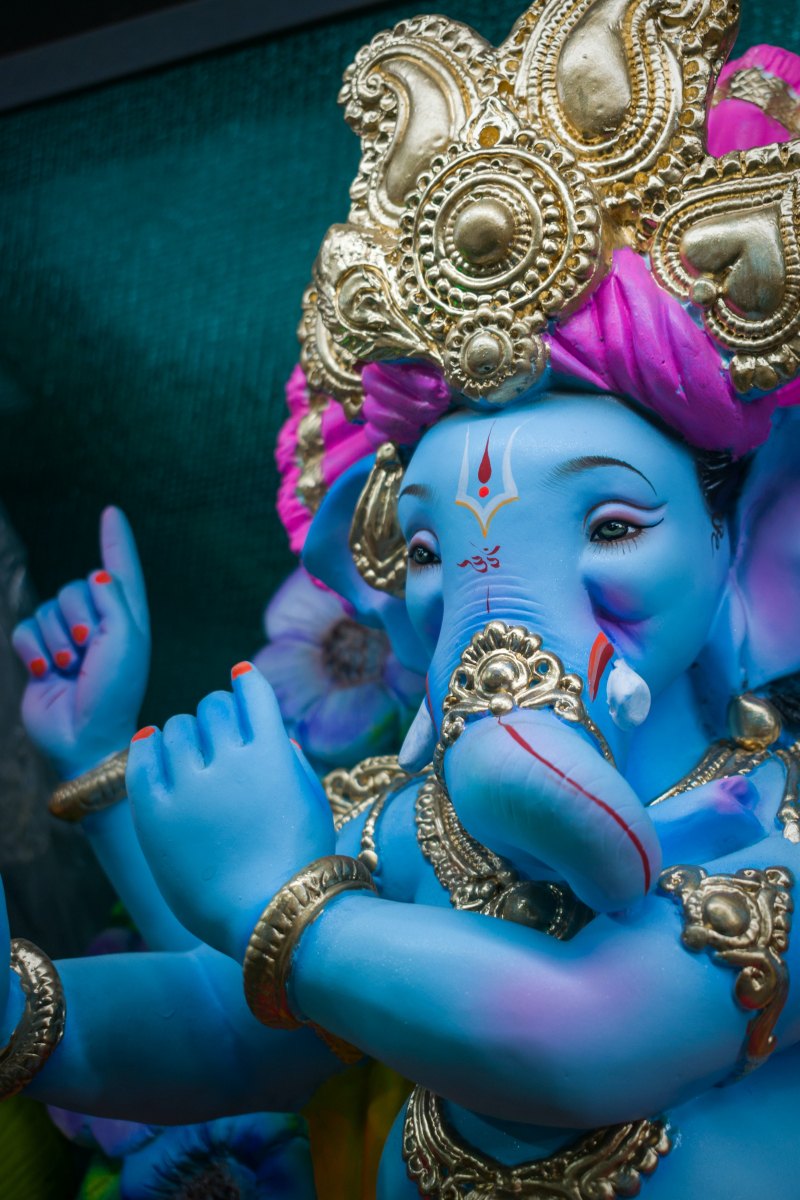Top 12 Most Powerful Mantras in Hinduism
Are you curious about the most powerful mantras in Hinduism? There are various Mantras for various purposes, just as there are various deities for various ... read more...energies. As a result, several deities are worshiped to and recited with various mantras. Even yet, there are some mantras that are extremely effective when sung in order to please a specific deity. Mantra chanting with devotion and trust attracts the positive and constructive energies of the deities involved. As a result, below are the most powerful mantras of famous Hindu gods and goddesses that we can chant in their honor.
-
ॐ भूर्भुवः स्वः
तत्सवितुर्वरेण्यं
भर्गो देवस्य धीमहि
धियो यो नः प्रचोदयात्॥Om Bhur Bhuvaḥ Swaḥ
Tat Savitur Vareṇyaṃ
Bhargo Devasya Dheemahi
Dhiyo Yo Nah Prachodayaat॥The meaning of the Gayatri Mantra:
- Om: The primordial sound, representing the essence of the universe.
- Bhur: The physical realm, representing the physical existence.
- Bhuvaḥ: The mental realm, representing life and consciousness.
- Swaḥ: The celestial realm, representing the spiritual world.
- Tat: That (referring to the divine reality or the Supreme).
- Savitur: The Sun, the source of all life and energy.
- Vareṇyaṃ: Most excellent or adored.
- Bhargo: Effulgence, brilliance, divine radiance.
- Devasya: Divine, of God.
- Dheemahi: We meditate or contemplate.
- Dhiyo: Intellect, understanding, wisdom.
- Yo: Who or which.
- Nah: Our.
- Prachodayaat: Inspire or enlighten.
The Gayatri Mantra is one of the most revered and ancient Vedic mantras in Hinduism. It is considered a sacred and powerful prayer for spiritual upliftment, wisdom, and enlightenment. The mantra is addressed to Goddess Gayatri, who is depicted as the divine embodiment of the Sun's energy and represents the Supreme Light of knowledge and wisdom.
The Gayatri Mantra is a prayer seeking the blessings of the divine energy (the Sun) to illuminate and guide our intellect and lead us toward righteousness and enlightenment. Chanting this mantra is believed to purify the mind, sharpen one's intellect, and cultivate spiritual awareness and inner wisdom. It is one of the most important and widely recited mantras in Hinduism and is a fundamental part of various rituals, meditations, and daily spiritual practices.

Photo on PICRYL Rajshri Soul -
ॐ त्र्यम्बकं यजामहेसुगन्धिं पुष्टिवर्धनम्उर्वारुकमिव बन्धनान्मृत्योर्मुक्षीय माऽमृतात्॥
Om Tryambakam YajamaheSugandhim Pushti-VardhanamUrvarukamiva BandhananMrityor Mukshiya Maamritat॥
The meaning of the Mahamrityunjaya Mantra:- Om: The primordial sound representing the essence of the universe.
- Tryambakam: The three-eyed Lord (referring to Lord Shiva).
- Yajamahe: We worship or meditate upon.
- Sugandhim: Fragrant, having a sweet aroma.
- Pushti-Vardhanam: Nourisher, bestower of prosperity and growth.
- Urvarukam: Cucumber-like or ripe fruit, symbolizing the cycle of birth and death.
- Iva: Like, as though.
- Bandhanan: Bound or tied.
- Mrityor: From death.
- Mukshiya: Liberates or grants liberation.
- Ma: Not.
- Amritat: Immortality, the nectar of eternal bliss.
The Mahamrityunjaya Mantra is one of the most potent and revered Vedic mantras in Hinduism. Also known as the Maha Mrityunjaya Mantra, it is dedicated to Lord Shiva, the destroyer and regenerator aspect of the Supreme Being. This mantra is chanted for protection, longevity, and overcoming the fear of death.
In essence, the Mahamrityunjaya Mantra is a prayer seeking Lord Shiva's blessings and protection to conquer the fear of death and attain liberation from the cycle of birth and death. Chanting this mantra is believed to have healing properties and bestow good health, well-being, and spiritual growth.
Devotees often recite this mantra during physical or mental distress, illness, or life-threatening situations. It is considered a powerful mantra for healing and inner transformation and a significant part of various religious ceremonies and spiritual practices in Hinduism.

Photo on Wikimedia Commons Sounds of Isha -
ॐ नमो भगवते वासुदेवाय।।
Om Namo Bhagwate Vasudevaya ||
- “ॐ” (Om): Om is a primordial and sacred sound in Hinduism
- “नमो” (Namo): Sanskrit word that signifies reverence and salutation
- “भगवते” (Bhagavate): The divine or the Supreme Being
- “वासुदेवाय” (Vasudevaya): This is the name of Lord Krishna, which refers to him as the son of Vasudeva, a king from the Yadu dynasty
This is a sacred mantra in Hinduism, and it is a chant devoted to Lord Vishnu, one of the principal deities in Hinduism. "Om Namo Bhagwate Vasudevaya" is a reverential invocation seeking the blessings and guidance of Lord Vasudeva (another name for Lord Vishnu). The mantra is often recited or meditated upon as a means to attain peace, spiritual enlightenment, and liberation from the cycle of birth and death (moksha).
In the Hindu tradition, chanting or meditating on this mantra is believed to have a purifying effect on the mind and soul, leading the devotee closer to the divine consciousness. It is used as a way to connect with the divine energy and express devotion and surrender to Lord Vishnu.
It is common to start and end various religious ceremonies, rituals, and spiritual practices with this mantra as a way to invoke the divine presence and seek divine blessings.
Photo on PICRYL Spiritual Mantra -
ॐ नमः शिवाय ||
Om Namah Shivaay ||
- “ॐ” (Om): Om is a sacred and primordial sound in Hinduism
- “नमः” (Namah): This word is derived from the root “Nam,” which means “to bow” or “to adore”
- “शिवाय” (Shivaya): The sacred name of Lord Shiva that denotes the auspicious, benevolent, and transformative aspect
This is another powerful and widely known mantra in Hinduism, dedicated to Lord Shiva, one of the principal deities in the Hindu pantheon. "Om Namah Shivaya" is a sacred chant that expresses devotion and reverence to Lord Shiva, the destroyer and transformer aspect of the Supreme Being.
The mantra combines the primordial sound "Om" and the five-syllable invocation "Namah Shivaya." Each syllable in the mantra represents various aspects and qualities of Lord Shiva. Reciting or meditating on this mantra is believed to help purify the mind, dissolve negative tendencies, and bring about spiritual growth and inner transformation.
Devotees of Lord Shiva often chant "Om Namah Shivaya" as part of their daily spiritual practice or during religious ceremonies. The mantra is considered a potent tool for connecting with the divine consciousness, seeking blessings, and achieving inner peace and liberation.
As with any sacred mantra, it is essential to approach it with sincerity, respect, and understanding its significance in Hindu spirituality.

Photo by Sandeep Singh: https://www.pexels.com/photo/photo-of-lord-shiva-statue-in-india-7104962/ Shiv Bhakti Sagar -
ॐ गम गणपतये नमः||
Om Gam Ganapataye Namaha||
- ॐ (Om): Sacred and powerful sound that represents the essence of the universe
- गम (Gam): Beej mantra or seed sound associated with Lord Ganesha
- गणपतये (Ganapataye): Name of Lord Ganesha, which refers to him as the Lord of Ganas
- नमः (Namaha): An expression of deep respect and surrender
This is a sacred mantra dedicated to Lord Ganesha, who is revered as the remover of obstacles and the harbinger of good fortune and wisdom.
The mantra "Om Gam Ganapataye Namaha" invokes the blessings and guidance of Lord Ganesha, the elephant-headed deity and the son of Lord Shiva and Goddess Parvati. By chanting this mantra with devotion, one seeks the removal of obstacles and the bestowal of success, knowledge, and prosperity.
The seed sound "Gam" is associated with Lord Ganesha and is believed to represent the essence of his energy. The mantra concludes with "Namaha," an expression of reverence, humility, and surrender to the divine.
Devotees of Lord Ganesha often recite this mantra at the beginning of any new endeavor, study, or important task to seek his blessings and overcome obstacles on the path to success. It is also commonly recited during Ganesha Chaturthi and other festivals dedicated to Lord Ganesha.
Photo by Sonika Agarwal: https://www.pexels.com/photo/a-beautiful-idol-of-lord-ganesha-in-mumbai-during-ganesh-chaturthi-2022-13078613/ Bhakti Bharat -
हरे कृष्ण हरे कृष्ण कृष्णा कृष्ण हरे हरे।
हरे राम हरे राम राम राम हरे हरे||
Hare Krishna Hare Krishna Krishna Krishna Hare Hare।
Hare Rama Hare Rama Rama Rama Hare Hare ||The Hare Krishna Maha Mantra is a powerful and widely known chant in the Hare Krishna movement (ISKCON) and other branches of Hinduism. It is considered a sublime and transformative practice of devotion.
The mantra consists of three names of the divine in the vocative case: Hare, Krishna, and Rama. Each name is repeated three times in succession, making a total of 16 words in the mantra.The chanting of this mantra is considered an effective way to connect with the divine, specifically with Lord Krishna and Lord Rama. It is believed to cleanse the mind, purify the heart, and elevate the consciousness to a state of spiritual awareness and devotion. Devotees of the Hare Krishna movement often engage in this chanting as part of their daily spiritual practice, meditation, or group gatherings known as kirtans.
The Hare Krishna Maha Mantra holds significant importance in the teachings of Bhakti Yoga, which emphasizes devotion and surrender to the Supreme through chanting, singing, and loving remembrance. The mantra's mellifluous rhythm and profound meaning have made it a cherished and universal practice among devotees worldwide.
Photo on Wikimedia Commons Spiritual Mantra -
सर्वमङ्गलमाङ्गल्ये शिवे सर्वार्थसाधिके।
शरण्ये त्र्यम्बके गौरि नारायणि नमोऽस्तु ते||
Sarva Mangala Mangalye Sive Sarvartha Sadhike।
Saranye Trayambike Gauri Narayani Namostute||
In this divine verse, the magnificent Goddess Durga is exalted and revered as the epitome of boundless auspiciousness, bestowing upon her devotees the fulfillment of their deepest desires. She is commonly known as "Trayambake," a moniker that translates to the three-eyed Goddess, symbolizing her formidable and safeguarding manifestation.
Discover the profound significance of the sacred shloka that fervently implores for the benevolent blessings and unwavering safeguard of the revered Goddess Durga. Revered as the epitome of divine motherhood and the ultimate wellspring of boundless vitality and fortitude, Goddess Durga stands as an embodiment of unparalleled power and grace.

Photo on Wallpaper Flare Spiritual Mantra -
ऊँ हं हनुमते रूद्रात्मकाय हुं फट् स्वाहा।।
Om Hang Hanumate Rudratamakaye Hum Phat Swaha ||
- “ॐ” (Om): Sacred and powerful sound that represents the essence of the universe
- “हं” (Han): Seed or beej mantra representing Lord Hanuman
- “हनुमते” (Hanumate): The vocative form of “Hanuman,” directly addressing Lord Hanuman
- “रूद्रात्मकाय” (Rudrātmakāya): Lord Hanuman as being an incarnation of Lord Rudra (Shiva)
- “हुं” (Hum): Beej mantra associated with Lord Hanuman to invoke his strength and protection
- “फट्” (Phat): Bija mantra to destroy obstacles and negativity
- “स्वाहा” (Swaha): An invocation to the deities
This is a powerful Hanuman mantra that invokes the blessings and protection of Lord Hanuman, who is considered an incarnation of Lord Rudra (Shiva) and is revered for his strength, devotion, and courage. Chanting this mantra with sincerity and devotion is believed to help overcome obstacles, remove negativity, and gain the grace of Lord Hanuman. The mantra is a way to seek the divine help and guidance of Hanuman for strength and spiritual growth.
Devotees often recite this mantra during times of difficulty, when facing challenges, or when seeking courage and inner strength. It is considered a potent tool to invoke the divine energy of Hanuman and to seek his protection and blessings.
Photo on Wikimedia Commons Bhajan Kirtan India -
The Saraswati Mantra is a sacred chant dedicated to Goddess Saraswati. One of the most well-known Saraswati Mantras is:
ॐ ऐं नमः।
Om Aim Namah।
- "ॐ" (Om), representing the universal and primordial sound.
- "ऐं" (Aim) is the seed sound associated with Goddess Saraswati.
Saraswati is the Hindu goddess of knowledge, music, arts, wisdom, and learning. She is considered the embodiment of creativity and intellect. Devotees invoke her blessings to seek knowledge, skill, and understanding in various academic and creative pursuits.
Chanting the Saraswati Mantra with devotion is believed to enhance one's learning capabilities, improve memory, and foster creativity and wisdom. Students often recite this mantra before exams or during their studies to seek the blessings and guidance of Goddess Saraswati.

Photo on Creazilla SPREAD JAINISM -
ॐ एइम ह्रीं श्रीं क्लिं सौह सतचिद एकं ब्रह्मा ||
Om Eim Hrim Shrim Klim Sauh Satchid Ekam Brahma ||
- ॐ (Om): Sacred and powerful sound that represents the essence of the universe
- एइम (Eim), ह्रीं (Hreem), श्रीं (Shreem), क्लिं (Kleem), and सौह (Sauh): Bija (seed) mantras representing the energy of Goddess Saraswati
- सतचिद (Sat-Chid): Existence or truth and consciousness or awareness
- एकं (Ekam): “one” or “the one”
- ब्रह्मा (Brahma): Lord Brahma
This mantra combines various Bija (seed) mantras associated with Goddess Saraswati and the words representing existence, consciousness, and Lord Brahma.
The mantra also includes the words "सतचिद एकं ब्रह्मा" (Satchid Ekam Brahma), which means "the one and only Supreme Reality, which is pure existence, consciousness, and Lord Brahma."Chanting this mantra is believed to invoke the divine blessings of Goddess Saraswati and the ultimate reality, leading to spiritual growth, wisdom, and success in creative and intellectual endeavors. It is often used as a powerful tool for meditation and to enhance one's connection with the higher consciousness.

Photo on Store norske leksikon GEBY MANTRA SOUNDS -
There are different versions of the Mahalakshmi Mantra, but one of the commonly recited mantras is:
ॐ श्रीं ह्रीं श्रीं कमले कमलालये प्रसीद प्रसीद
ॐ श्रीं ह्रीं श्रीं महालक्ष्मयै नमः॥
Om Shreem Hreem Shreem Kamale Kamalalaye Praseed Praseed
Om Shreem Hreem Shreem Mahalakshmayai Namah॥
The meaning of the Mahalakshmi Mantra:
- Om: The primordial sound, representing the essence of the universe.
- Shreem: Represents the divine energy of Goddess Lakshmi, associated with wealth and abundance.
- Hreem: Represents the divine energy of Goddess Lakshmi, associated with purity and spiritual growth.
- Kamale Kamalalaye: Refers to the lotus-like Goddess Lakshmi, who resides in the hearts of devotees.
- Praseed Praseed: An earnest prayer seeking blessings and grace from Goddess Lakshmi.
- Mahalakshmayai Namah: Salutations and reverence to Goddess Mahalakshmi.
This is a powerful and auspicious mantra dedicated to Goddess Lakshmi, the Hindu deity of wealth, prosperity, and abundance. The mantra seeks the blessings and grace of Goddess Lakshmi to remove all obstacles and bestow wealth, prosperity, and children upon the devotee.
Chanting this mantra with devotion is believed to invoke the blessings of Goddess Lakshmi and attract positive energy, prosperity, and abundance into one's life. It is often recited during various Hindu rituals, especially during Diwali and other occasions dedicated to Goddess Lakshmi, to seek her blessings and divine grace for a prosperous and fulfilling life.
By chanting this mantra, devotees express their gratitude and reverence to Goddess Lakshmi and seek her divine benevolence for removing financial difficulties and attaining material and spiritual abundance.
Maa Laxmi - Photo on Wikimedia Commons Nova Spiritual India -
ॐ श्री रामाय नमः॥
Om Shri Ramaya Namah॥
- ॐ (Om): Sacred and primordial sound in Hinduism
- श्री रामाय (Shri Ramaya): “Shri Ramaya” refers to Lord Rama
- नमः (Namaha): “I bow down” or “I offer my salutations”
This is a sacred mantra dedicated to Lord Rama, one of the most revered and beloved deities in Hinduism. Lord Rama is considered the seventh avatar of Lord Vishnu and is renowned for his qualities of righteousness, compassion, and devotion to dharma (righteousness).
The mantra "Om Shri Ramaya Namah" is a heartfelt expression of devotion and reverence to Lord Rama. By chanting this mantra, devotees offer their salutations and surrender to the divine qualities and virtues represented by Lord Rama. It is a way to connect with the divine and seek his blessings, protection, and guidance in life.
Lord Rama's life and teachings, as depicted in the ancient epic Ramayana, have been a source of inspiration and guidance for millions of people across generations. Chanting this mantra with devotion is believed to bring inner peace, strength, and spiritual upliftment.
Devotees often recite this mantra as a daily practice or during special occasions, seeking Lord Rama's grace and divine presence in their lives.
Lord Rama - Photo on Rawpixel CYCLEdotIN

































